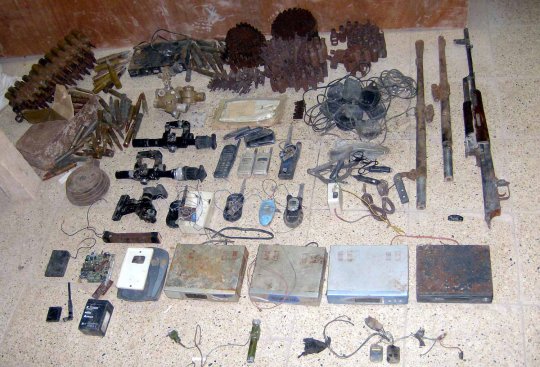
Tipsters lead to capture of south Baghdad’s most wanted terrorist, cache
2nd Brigade Combat Team
10th Mountain Division Public Affairs Office
AL-DHOUR — With two well-timed phone calls, Iraqi civilians made a few Soldiers’ day recently.
The first tipster called
Troop C, 1st Squadron, 89th Cavalry Regiment, 2nd Brigade Combat Team, 10th Mountain Division (Light Infantry) out of Fort Drum, N.Y., and alerted them to a cache south of the village of Al-Dhour, south of Baghdad.
The troop responded, located the buried weapons, and was only five minutes into the process of digging them up when they got another call.
A man claimed he had the 2nd BCT’s top high-value target and would deliver him to coalition custody. The man and Capt. Adam Sawyer, Troop C commander, agreed on a pickup site.
The Soldiers hastily re-buried the cache and moved out. When the vehicle arrived, they stopped it and took the most wanted man and two other men into custody.
Some of the Soldiers were still able to see the cache from their vantage point, and were surprised to see a civilian pickup truck stop there and begin hastily loading the weapons into the bed of the truck.
They engaged the vehicle with an M-240 machine gun. The men tried to flee, but the Troop C Soldiers detained them all and called an explosive ordnance disposal team to destroy the weapons.
Sawyer, a native of Reading, Pa., was jubilant about the operation.
“All of this was possible because of sources we’ve developed, through local-national engagements and working with the residents of the area,” he said. “It’s our work with the people in these areas, our relations with them, paying off.”
The primary target is allegedly responsible for shooting down an AH-64 helicopter in April 2006, the abductions of two Soldiers in June 2006, and complex attacks on patrol bases and terrorist acts against both coalition forces and Iraqi civilians.
Additionally, he is believed to be the leader of an al-Qaida network, known to prey on the general public through intimidation and murder against those resisting compliance to the al-Qaida demands and decrees.
One of the detainees had been wounded in a previous engagement, and was taken to a coalition hospital for treatment. The other six are being held for further questioning.
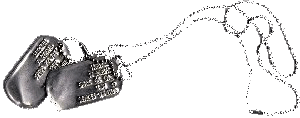
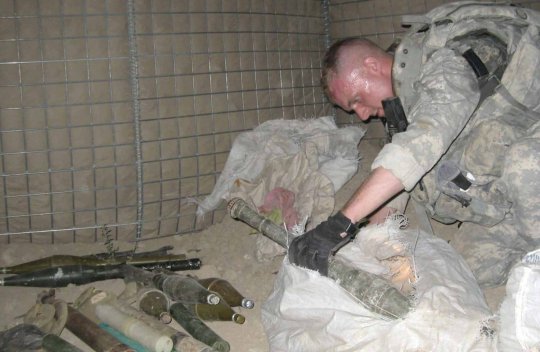
Iraqi informants lead U.S. Soldiers to weapons, IED caches
RUSHDI MULLAH — Iraqi informants led coalition forces to three massive caches north of Rushdi Mullah, July 18.
Accompanying the informants were Soldiers of Company C, 2nd Battalion, 14th Infantry Regiment, 2nd Brigade Combat Team, 10th Mountain Division (Light Infantry) out of Fort Drum, N.Y., who helped seize the caches just 20 miles south of Baghdad.
“Over the last several weeks, the number of Iraqis who have been sharing tips with us is astounding,” said Maj. Web Wright, a spokesperson for the 2nd BCT. “There has been a turning of the tides against al-Qaida in this area. The people are tired of them and are turning their backs on AQI.”
All three caches were found buried in 55-gallon drums within 100 meters of one another.
The contents of the caches included 13 rocket propelled grenades, 150 bags of Russian mortar propellant charges, two 57 mm mortar rockets, an armor-piercing rocket propelled grenade, four cylindrical explosive charges, two square explosive charges, two hand-launched star cluster flares, a Russian fragmentary hand grenade, 25 mortar propellant charges, 100 12.7 mm DiSHKA heavy machine gun rounds, 20 25 mm rounds, a 75-round Ak-47 ammunition drum, three sniper rifle scopes, two mortar sights, 10 cell phone chargers, five radios, a pressure plate, a machine gun lower receiver, two 7.62 mm machine gun barrels, two bottles of glucose, four vehicle cell phone chargers, an improvised explosive device command wire initiator, a hands-free telephone headset, an eight-battery holder, four cell phone batteries, a 4.8 voltage rechargeable battery, a seven-piece antenna, two flip-open cell phones, four Motorola talk-abouts, a cordless phone, a cordless phone base, a toy cell phone improvised explosive device (IED) initiator, two phone cords, an antenna extension, two keyless-entry devices with IED initiator switches, two magnets, two circuit boards and various nuts and bolts.
Radio and cell phone accessories are commonly used to detonate IEDs.
An explosive ordnance disposal team destroyed the ordnance.

BAGHDAD
Soldiers from the 3rd Squadron, 1st Cavalry Regiment detained one of the Multi-National Division-Center’s most wanted insurgents, along with four other individuals early Friday morning near Jisr Diyala.
Leaders from 3-1 Cav. gained intelligence early Friday morning that the known insurgent and a number of his associates were within their area of operations.
Soldiers conducted a surprise raid and captured the individual with no U.S. forces injuries or damage to equipment, by surrounding the house following a 2-mile walk into the suspected insurgent’s neighborhood. It was well-known to the Soldiers that the individual was on the look out for Army aircraft and would move if he heard helicopters approaching.
The detained “high-value individual” is believed to be responsible for the recent increase in explosively formed projectile improvised explosive devices and indirect fire attacks against Coalition Forces east of Baghdad. He is also suspected of intimidating Iraqis that work with U.S. forces, as well as, kidnapping and murdering rivals of his cell.
In addition to his terrorist activities, the detainee is a member of an organized crime network in the Mada’in Qada, which is part of the Baghdad province. Coalition Forces believe the detainee has extorted the local population through his water distribution company and gas station enterprises.
The 3-1 Cav. is assigned to the 3rd Heavy Brigade Combat Team and is from Fort Benning, Ga. The unit deployed to Iraq in March 2007.

Wild Thikng’s comment……..
Our troops ROCK! Prayers for them every day and for their families.
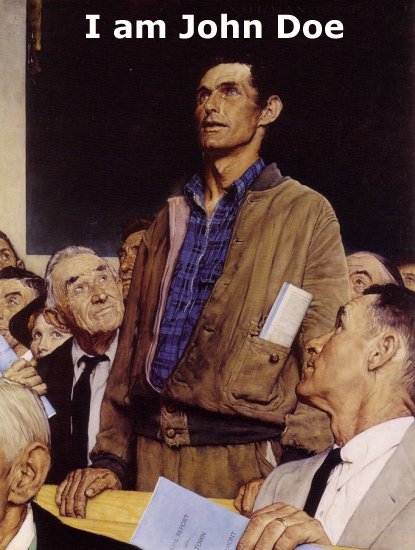









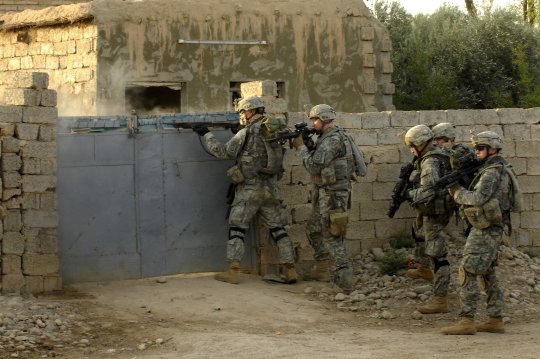
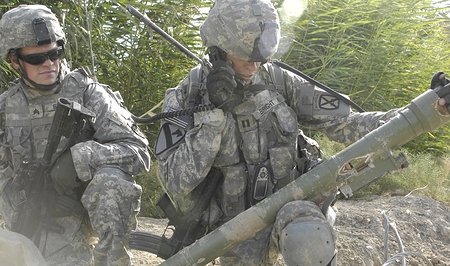
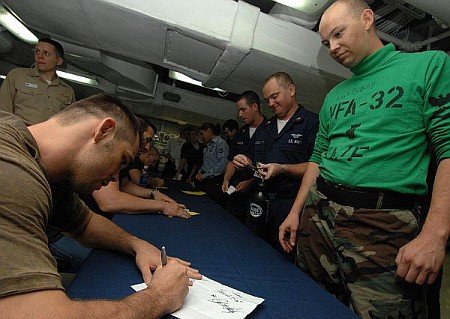
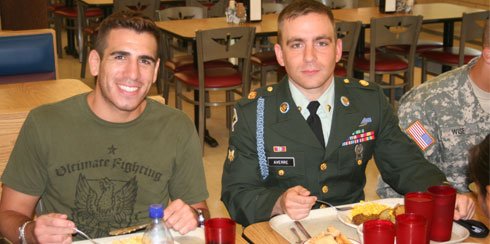


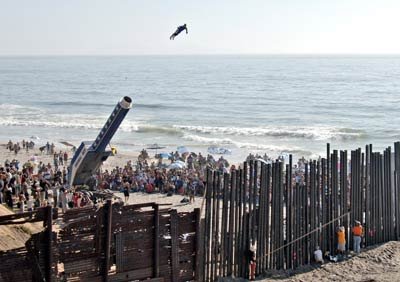
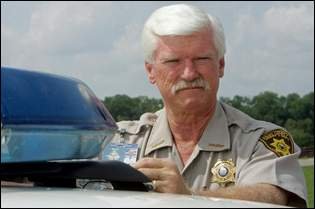



Recent Comments